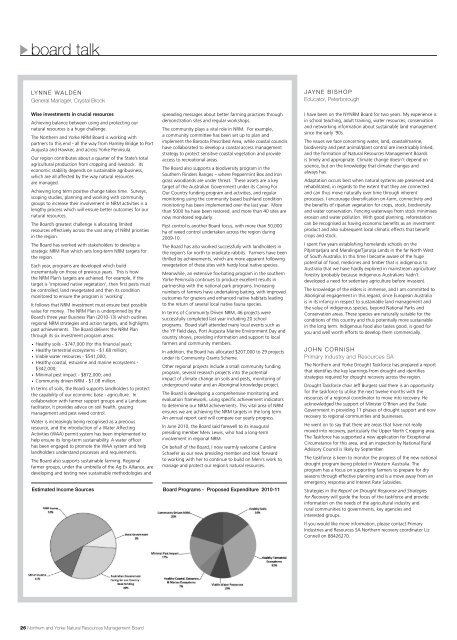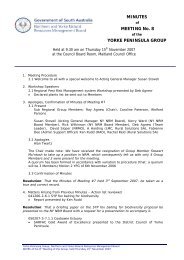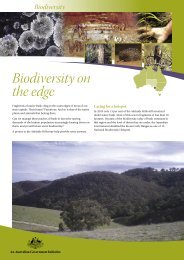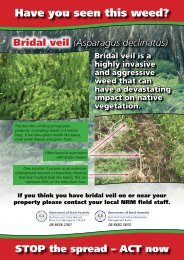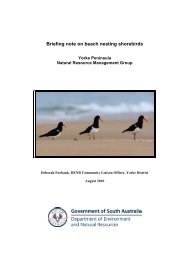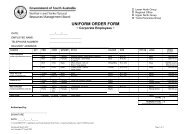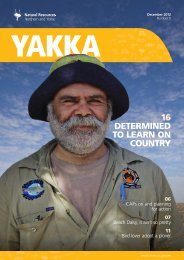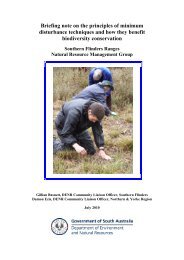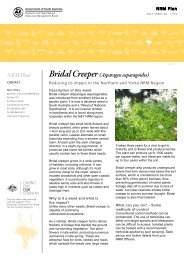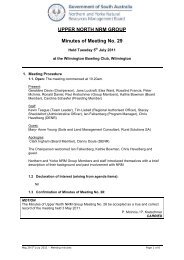Caring for country - Northern and Yorke Natural Resources ...
Caring for country - Northern and Yorke Natural Resources ...
Caring for country - Northern and Yorke Natural Resources ...
You also want an ePaper? Increase the reach of your titles
YUMPU automatically turns print PDFs into web optimized ePapers that Google loves.
4board talk<br />
Lynne walden<br />
General Manager, Crystal Brook<br />
Wise investments in crucial resources<br />
Achieving balance between using <strong>and</strong> protecting our<br />
natural resources is a huge challenge.<br />
The <strong>Northern</strong> <strong>and</strong> <strong>Yorke</strong> NRM Board is working with<br />
partners to this end - all the way from Hamley Bridge to Port<br />
Augusta <strong>and</strong> Hawker, <strong>and</strong> across <strong>Yorke</strong> Peninsula.<br />
Our region contributes about a quarter of the State’s total<br />
agricultural production from cropping <strong>and</strong> livestock. Its<br />
economic stability depends on sustainable agribusiness,<br />
which are all affected by the way natural resources<br />
are managed.<br />
Achieving long term positive change takes time. Surveys,<br />
scoping studies, planning <strong>and</strong> working with community<br />
groups to increase their involvement in NRM activities is a<br />
lengthy process which will ensure better outcomes <strong>for</strong> our<br />
natural resources.<br />
The Board’s greatest challenge is allocating limited<br />
resources effectively across the vast array of NRM priorities<br />
in the region.<br />
The Board has worked with stakeholders to develop a<br />
strategic NRM Plan which sets long-term NRM targets <strong>for</strong><br />
the region.<br />
Each year, programs are developed which build<br />
incrementally on those of previous years. This is how<br />
the NRM Plan’s targets are achieved. For example, if the<br />
target is ‘improved native vegetation’, then first pests must<br />
be controlled, l<strong>and</strong> revegetated <strong>and</strong> then its condition<br />
monitored to ensure the program is ‘working’.<br />
It follows that NRM investment must ensure best possible<br />
value <strong>for</strong> money. The NRM Plan is underpinned by the<br />
Board’s three year Business Plan (2010-13) which outlines<br />
regional NRM strategies <strong>and</strong> action targets, <strong>and</strong> highlights<br />
past achievements. The Board delivers the NRM Plan<br />
through its six investment program areas:<br />
• Healthy soils - $747,000 (<strong>for</strong> this financial year);<br />
• Healthy terrestrial ecosystems - $1.68 million;<br />
• Viable water resources - $541,000;<br />
• Healthy coastal, estuarine <strong>and</strong> marine ecosystems -<br />
$342,000;<br />
• Minimal pest impact - $872,000; <strong>and</strong><br />
• Community driven NRM - $1.08 million.<br />
In terms of soils, the Board supports l<strong>and</strong>holders to protect<br />
the capability of our economic base - agriculture. In<br />
collaboration with farmer support groups <strong>and</strong> a L<strong>and</strong>care<br />
facilitator, it provides advice on soil health, grazing<br />
management <strong>and</strong> pest weed control.<br />
Water is increasingly being recognised as a precious<br />
resource, <strong>and</strong> the introduction of a Water Affecting<br />
Activities (WAA) permit system has been implemented to<br />
help ensure its long-term sustainability. A water officer<br />
has been engaged to promote the WAA system <strong>and</strong> help<br />
l<strong>and</strong>holders underst<strong>and</strong> processes <strong>and</strong> requirements.<br />
The Board also supports sustainable farming. Regional<br />
farmer groups, under the umbrella of the Ag Ex Alliance, are<br />
developing <strong>and</strong> testing new sustainable methodologies <strong>and</strong><br />
spreading messages about better farming practices through<br />
demonstration sites <strong>and</strong> regular workshops.<br />
The community plays a vital role in NRM. For example,<br />
a community committee has been set up to plan <strong>and</strong><br />
implement the Baroota Prescribed Area, while coastal councils<br />
have collaborated to develop a coastal access management<br />
strategy to protect sensitive coastal vegetation <strong>and</strong> provide<br />
access to recreational areas.<br />
The Board also supports a biodiversity program in the<br />
Southern Flinders Ranges – where Peppermint Box <strong>and</strong> Iron<br />
grass woodl<strong>and</strong>s are under threat. These assets are a key<br />
target of the Australian Government under its <strong>Caring</strong> For<br />
Our Country funding program <strong>and</strong> activities, <strong>and</strong> regular<br />
monitoring using the community based bushl<strong>and</strong> condition<br />
monitoring has been implemented over the last year. More<br />
than 5000 ha have been restored, <strong>and</strong> more than 40 sites are<br />
now monitored regularly.<br />
Pest control is another Board focus, with more than 50,000<br />
ha of weed control undertaken across the region during<br />
2009-10.<br />
The Board has also worked successfully with l<strong>and</strong>holders in<br />
the region’s far north to eradicate rabbits. Farmers have been<br />
thrilled by achievements, which are more apparent following<br />
revegetation of these sites with hardy local native species.<br />
Meanwhile, an extensive fox-bating program in the southern<br />
<strong>Yorke</strong> Peninsula continues to produce excellent results in<br />
partnership with the national park programs. Increasing<br />
numbers of farmers have undertaking baiting, with improved<br />
outcomes <strong>for</strong> graziers <strong>and</strong> enhanced native habitats leading<br />
to the return of several local native fauna species.<br />
In terms of Community Driven NRM, 46 projects were<br />
successfully completed last year including 20 school<br />
programs. Board staff attended many local events such as<br />
the YP Field days, Port Augusta Marine Environment Day <strong>and</strong><br />
<strong>country</strong> shows, providing in<strong>for</strong>mation <strong>and</strong> support to local<br />
farmers <strong>and</strong> community members.<br />
In addition, the Board has allocated $207,000 to 29 projects<br />
under its Community Grants Scheme.<br />
Other regional projects include a small community funding<br />
program, several research projects into the potential<br />
impact of climate change on soils <strong>and</strong> pests, monitoring of<br />
underground water <strong>and</strong> an Aboriginal knowledge project.<br />
The Board is developing a comprehensive monitoring <strong>and</strong><br />
evaluation framework, using specific achievement indicators<br />
to determine our NRM achievements. This vital area of NRM<br />
ensures we are achieving the NRM targets in the long term.<br />
An annual report card will compare our yearly progress.<br />
In June 2010, the Board said farewell to its inaugural<br />
presiding member Merv Lewis, who had a long-term<br />
involvement in regional NRM.<br />
On behalf of the Board, I now warmly welcome Caroline<br />
Schaefer as our new presiding member <strong>and</strong> look <strong>for</strong>ward<br />
to working with her to continue to build on Merv’s work to<br />
manage <strong>and</strong> protect our region’s natural resources.<br />
Estimated Income Sources Board Programs - Proposed Expenditure 2010-11<br />
Jayne Bishop<br />
Educator, Peterborough<br />
I have been on the NYNRM Board <strong>for</strong> two years. My experience is<br />
in school teaching, adult training, water resources, conservation<br />
<strong>and</strong> networking in<strong>for</strong>mation about sustainable l<strong>and</strong> management<br />
since the early ‘90s.<br />
The issues we face concerning water, l<strong>and</strong>, coastal/marine,<br />
biodiversity <strong>and</strong> pest animal/plant control are inextricably linked,<br />
<strong>and</strong> the <strong>for</strong>mation of <strong>Natural</strong> <strong>Resources</strong> Management Boards<br />
is timely <strong>and</strong> appropriate. Climate change doesn’t depend on<br />
science, but on the knowledge that climate changes <strong>and</strong><br />
always has.<br />
Adaptation occurs best when natural systems are preserved <strong>and</strong><br />
rehabilitated, in regards to the extent that they are connected<br />
<strong>and</strong> can thus move naturally over time through inherent<br />
processes. I encourage diversification on-farm, connectivity <strong>and</strong><br />
the benefits of riparian vegetation <strong>for</strong> crops, stock, biodiversity<br />
<strong>and</strong> water conservation. Fencing waterways from stock minimises<br />
erosion <strong>and</strong> water pollution. With good planning, re<strong>for</strong>estation<br />
can be recognised as having economic benefits as an investment<br />
product <strong>and</strong> also subsequent local climatic effects that benefit<br />
crops <strong>and</strong> stock.<br />
I spent five years establishing homel<strong>and</strong>s schools on the<br />
Pitjantjatjara <strong>and</strong> Maralinga/Tjarutja L<strong>and</strong>s in the far North West<br />
of South Australia. In this time I became aware of the huge<br />
potential of food, medicines <strong>and</strong> timber that is indigenous to<br />
Australia that we have hardly explored in mainstream agriculture/<br />
<strong>for</strong>estry (probably because indigenous Australians hadn’t<br />
developed a need <strong>for</strong> sedentary agriculture be<strong>for</strong>e invasion).<br />
The knowledge of the elders is immense, <strong>and</strong> I am committed to<br />
Aboriginal engagement in this regard, since European Australia<br />
is in its infancy in respect to sustainable l<strong>and</strong> management <strong>and</strong><br />
the value of indigenous species, beyond National Parks <strong>and</strong><br />
Conservation areas. These species are naturally suitable <strong>for</strong> the<br />
conditions of this <strong>country</strong> <strong>and</strong> thus potentially more sustainable<br />
in the long term. Indigenous food also tastes good, is good <strong>for</strong><br />
you <strong>and</strong> well worth ef<strong>for</strong>ts to develop them commercially.<br />
John Cornish<br />
Primary Industry <strong>and</strong> <strong>Resources</strong> SA<br />
The <strong>Northern</strong> <strong>and</strong> <strong>Yorke</strong> Drought Task<strong>for</strong>ce has prepared a report<br />
that identifies the key learnings from drought <strong>and</strong> identifies<br />
strategies required <strong>for</strong> drought recovery across the region.<br />
Drought Task<strong>for</strong>ce chair Jeff Burgess said there is an opportunity<br />
<strong>for</strong> the task<strong>for</strong>ce to utilise the next twelve months with the<br />
resources of a regional coordinator to move into recovery. He<br />
acknowledged the support of Minister O’Brien <strong>and</strong> the State<br />
Government in providing 11 phases of drought support <strong>and</strong> now<br />
recovery to regional communities <strong>and</strong> businesses.<br />
He went on to say that there are areas that have not really<br />
moved into recovery, particularly the Upper North Cropping area.<br />
The Task<strong>for</strong>ce has supported a new application <strong>for</strong> Exceptional<br />
Circumstance <strong>for</strong> this area, <strong>and</strong> an inspection by National Rural<br />
Advisory Council is likely by September.<br />
The task<strong>for</strong>ce is keen to monitor the progress of the new national<br />
drought program being piloted in Western Australia. The<br />
program has a focus on supporting farmers to prepare <strong>for</strong> dry<br />
seasons through effective planning <strong>and</strong> is a move away from an<br />
emergency response <strong>and</strong> Interest Rate Subsidies.<br />
Strategies in the Report on Drought Response <strong>and</strong> Strategies<br />
<strong>for</strong> Recovery will guide the focus of the task<strong>for</strong>ce <strong>and</strong> provide<br />
in<strong>for</strong>mation on the needs of the agricultural industry <strong>and</strong><br />
rural communities to governments, key agencies <strong>and</strong><br />
interested groups.<br />
If you would like more in<strong>for</strong>mation, please contact Primary<br />
Industries <strong>and</strong> <strong>Resources</strong> SA <strong>Northern</strong> recovery coordinator Liz<br />
Connell on 88426270.<br />
26 <strong>Northern</strong> <strong>and</strong> <strong>Yorke</strong> <strong>Natural</strong> <strong>Resources</strong> Management Board


